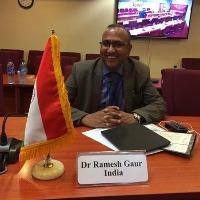Dr. Ramesh C Gaur works at the Jawaharlal Nehru University
At the outset, let me congratulate all on initiating 30th November as the International Digital Preservation Day (IDPD17).
My introduction to digital preservation started in 2005 when I visited Germany with the support of Max Mueller Bhawan. My three-week stay, one week each at Belfield University, Belfield; German National Library Frankfurt; and State Gottingen University Library, Gottingen; provided me opportunity to closely study some of the digital preservation initiatives in Germany in particular and in Europe in general. The interaction with researchers working at project like NESTOR, KOPOL, and REUSE, etc., helped me in learning the basics of digital preservation. After coming back from Germany, I shared my experience in the form of various lectures delivered at various national and international conferences in India. Since then, digital preservation is one of the prime area of my interest.
Digital preservation is a process of preserving both digitized and born-digital contents to a distant future in reusable condition for access by its users. It involves a set of systematic guidelines, processes, strategies, technology and approaches.' The technological obsolescence, shorter and uncertain life-period for current storage media, information glut, and internet revolution are some of the major factors which have made preservation of digital information more complex and challenging. Being a librarian, preservation for access is key to my thought process.
Digitization refers to a process for converting print and other non-print materials into digital format for easy access to users. Both print and non-print material has a certain life. So, to preserve these materials beyond that life, we need to adopt long term preservation methods. We may have options like microfilm and digitization as popular methods of long term preservation. However for efficient and effective access system libraries prefer to go for digitization. Certainly digitization help in wider access along with long term digital preservation. The sharing to multiple users at a time; remote access and availability in multiple formats are some of the other advantages of digitization.
As one of the most ancient cultural civilizations , India is a country of vast cultural heritage resources both tangible and intangible. With an estimated 5 million ancient manuscripts, India is the largest repository of manuscripts. These manuscripts are on religion, astrology, astronomy, mathematics and ancient medicines. Indira Gandhi National Centre for Arts(www.ignca.gov.in) and later National Mission for Manuscripts (NMM) nmm.gov.in has digitized over 4,00,000 Indian ancient manuscripts. Most of these digitized manuscripts are stored in DVDs/File Savers. Due to lack of proper digital preservation policy, users are still not able to access it online. Access and digital preservation both are equally important. Besides, a large amount of other cultural resources are available in various archives and museums in India. The preservation of these resources was never a priority subject, so large resources have either vanished or have gone out of India. An approach on preservation of its physical resources was never discussed. In similar way, the concepts of digital preservation have been introduced in India very lately, i.e., sometime in year 2008 only. A good beginning was made with the launch of National Digital Preservation Programme(NDPP) of India. However, due to lack of continuity of the programme, still we are far from having a proper National Digital Preservation Programme in place. There are number of issues and challenges to overcome to various barriers to access and preservation of Indian cultural heritage resources. There are number of individual efforts, but we are still looking for a successful collaborative model. I have a fear that if something is not being done sooner, we may lose, the digitized material currently lying in DVDs and File Savers. What we need right now, a comprehensive National Digital Preservation Programme.
Some new initiatives like National Digital Library of India https://ndl.iitkgp.ac.in/ and a project like National Virtual Library of India may be some steps ahead in this direction but not the right step towards digital preservation of Indian contents. I hope librarians, IT professionals and policy makers in India will come together to develop National Digital Preservation programme.
